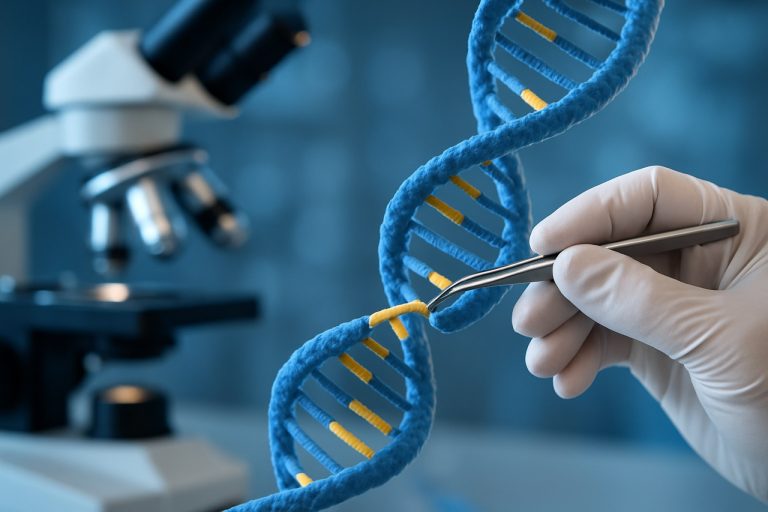
Unlocking the Power of CRISPR-Based Epigenetic State Editing: Transforming How We Control Gene Expression. Discover the Next Frontier in Precision Medicine and Biotechnology.
- Introduction to CRISPR-Based Epigenetic State Editing
- Mechanisms: How CRISPR Modifies Epigenetic Marks
- Key Technologies and Tools in Epigenetic Editing
- Applications in Disease Research and Therapy
- Advantages Over Traditional Gene Editing
- Challenges and Limitations
- Ethical and Regulatory Considerations
- Future Directions and Emerging Trends
- Sources & References
Introduction to CRISPR-Based Epigenetic State Editing
CRISPR-based epigenetic state editing represents a transformative approach in the field of genome engineering, enabling precise and reversible modulation of gene expression without altering the underlying DNA sequence. Unlike traditional CRISPR-Cas9 systems that induce double-stranded breaks for gene knockout or correction, epigenetic editing leverages catalytically inactive Cas9 (dCas9) fused to epigenetic effector domains. These engineered complexes can be guided to specific genomic loci by single-guide RNAs (sgRNAs), where they deposit or remove epigenetic marks such as DNA methylation, histone acetylation, or methylation, thereby modulating chromatin accessibility and gene activity Nature Reviews Genetics.
This technology offers several advantages over conventional genetic editing. It allows for the fine-tuning of gene expression, the study of non-coding regulatory elements, and the investigation of epigenetic mechanisms underlying development and disease. Importantly, because the DNA sequence remains unaltered, CRISPR-based epigenetic editing reduces the risk of permanent off-target mutations and may be more amenable to therapeutic applications where reversibility and safety are paramount Cell Press.
Recent advances have expanded the repertoire of epigenetic effectors and improved the specificity and efficiency of these systems. Applications now span from basic research—such as dissecting gene regulatory networks—to potential clinical interventions for diseases driven by aberrant epigenetic states, including cancer and neurological disorders Nature Biotechnology. As the field matures, CRISPR-based epigenetic state editing is poised to become a cornerstone technology for both functional genomics and precision medicine.
Mechanisms: How CRISPR Modifies Epigenetic Marks
CRISPR-based epigenetic state editing leverages the programmable DNA-binding capability of catalytically inactive Cas9 (dCas9) fused to epigenetic effector domains to modulate gene expression without altering the underlying DNA sequence. The dCas9 protein, guided by a single-guide RNA (sgRNA), is directed to specific genomic loci, where it recruits effector proteins that can add or remove epigenetic marks such as DNA methylation, histone acetylation, or methylation. For example, fusion of dCas9 to the Krüppel-associated box (KRAB) domain enables targeted deposition of repressive histone marks (e.g., H3K9me3), leading to transcriptional silencing, while fusion to histone acetyltransferases like p300 can promote histone acetylation (e.g., H3K27ac), resulting in gene activation Nature.
Additionally, dCas9 can be fused to DNA methyltransferases (e.g., DNMT3A) or demethylases (e.g., TET1) to directly modify DNA methylation at targeted loci, thereby influencing gene expression in a heritable manner Cell. Multiplexing is possible by using multiple sgRNAs or orthogonal dCas9 variants, allowing simultaneous editing of several epigenetic marks or loci. These approaches enable precise, locus-specific modulation of the epigenome, providing powerful tools for dissecting gene regulatory mechanisms and developing potential therapeutic strategies for diseases with epigenetic dysregulation Nature Reviews Genetics.
Key Technologies and Tools in Epigenetic Editing
CRISPR-based epigenetic state editing leverages the precision of CRISPR/Cas systems to modulate gene expression without altering the underlying DNA sequence. Central to this approach is the use of catalytically inactive Cas9 (dCas9), which can be fused to various effector domains to target specific epigenetic modifications. Key technologies include dCas9 fused to transcriptional activators (such as VP64, p300) or repressors (such as KRAB), enabling targeted activation or silencing of genes by modifying histone acetylation or methylation states at specific loci. These tools allow researchers to dissect gene regulatory networks and study the functional consequences of epigenetic changes in a highly controlled manner.
Recent advances have expanded the CRISPR toolbox to include dCas9 fusions with DNA methyltransferases (e.g., DNMT3A) or demethylases (e.g., TET1), enabling locus-specific DNA methylation editing. Additionally, the development of CRISPR interference (CRISPRi) and CRISPR activation (CRISPRa) platforms has facilitated high-throughput screening of regulatory elements and non-coding regions. Multiplexed editing, achieved by delivering multiple guide RNAs, allows simultaneous modulation of several epigenetic marks or genes, further enhancing the versatility of these systems.
Delivery methods remain a critical consideration, with viral vectors, nanoparticles, and electroporation being commonly used to introduce CRISPR-based epigenetic editors into cells. The specificity and efficiency of these tools continue to improve, driven by innovations in guide RNA design and effector domain engineering. Collectively, these technologies are transforming our ability to interrogate and manipulate the epigenome, with broad implications for basic research and therapeutic development (Nature Reviews Genetics, Cell).
Applications in Disease Research and Therapy
CRISPR-based epigenetic state editing has rapidly emerged as a transformative tool in disease research and therapeutic development. Unlike traditional CRISPR-Cas9 genome editing, which introduces permanent DNA sequence changes, epigenetic editing employs catalytically inactive Cas9 (dCas9) fused to epigenetic modifiers to reversibly modulate gene expression without altering the underlying DNA sequence. This approach enables precise control over gene activity, offering significant advantages for studying gene function and developing targeted therapies for complex diseases.
In disease research, CRISPR-based epigenetic editing allows scientists to mimic disease-associated epigenetic states, facilitating the dissection of causal relationships between epigenetic modifications and disease phenotypes. For example, targeted DNA methylation or histone modification can be used to silence oncogenes or reactivate tumor suppressor genes in cancer models, providing insights into tumorigenesis and potential intervention points. Similarly, in neurological disorders, epigenetic editing has been used to modulate the expression of genes implicated in synaptic function and neurodegeneration, advancing our understanding of disease mechanisms and identifying new therapeutic targets (Nature Reviews Genetics).
Therapeutically, CRISPR-based epigenetic editing holds promise for treating diseases with an epigenetic component, such as certain cancers, imprinting disorders, and neurodevelopmental syndromes. Preclinical studies have demonstrated the feasibility of using dCas9-fused effectors to restore normal gene expression patterns and ameliorate disease phenotypes in animal models (Cell). Ongoing research is focused on improving delivery methods, specificity, and long-term safety to enable clinical translation. As these technologies mature, they are expected to expand the therapeutic landscape for previously intractable diseases.
Advantages Over Traditional Gene Editing
CRISPR-based epigenetic state editing offers several advantages over traditional gene editing techniques, particularly in its ability to modulate gene expression without altering the underlying DNA sequence. Unlike conventional CRISPR-Cas9 systems that introduce double-strand breaks to disrupt or correct genes, epigenetic editing employs catalytically inactive Cas9 (dCas9) fused to epigenetic modifiers, such as DNA methyltransferases or histone acetyltransferases. This approach enables precise, reversible, and tunable regulation of gene activity, minimizing the risk of permanent off-target mutations and genomic instability associated with DNA cleavage-based methods (Nature Reviews Genetics).
Another significant advantage is the potential for multiplexed and locus-specific control of multiple genes or regulatory elements simultaneously. By designing guide RNAs targeting different genomic loci, researchers can orchestrate complex gene networks and study combinatorial effects on cellular phenotypes (Cell). Furthermore, epigenetic editing is particularly valuable for investigating non-coding regions and regulatory elements, which are often inaccessible or difficult to manipulate using traditional gene editing tools.
Importantly, the reversibility of epigenetic modifications allows for dynamic studies of gene function and the development of therapeutic strategies that can be fine-tuned or withdrawn if adverse effects arise. This feature is especially relevant for clinical applications, where permanent genetic changes may pose safety concerns (Nature Biotechnology). Collectively, these advantages position CRISPR-based epigenetic state editing as a powerful and versatile tool for both basic research and translational medicine.
Challenges and Limitations
Despite the transformative potential of CRISPR-based epigenetic state editing, several challenges and limitations hinder its widespread application. One major concern is the specificity of targeting. While CRISPR-dCas9 fusion proteins can be directed to precise genomic loci, off-target binding remains a risk, potentially leading to unintended epigenetic modifications and unpredictable gene expression changes. This off-target activity is influenced by the guide RNA sequence and the chromatin context, necessitating rigorous validation and optimization for each application (Nature Reviews Genetics).
Another limitation is the durability and reversibility of epigenetic modifications. Unlike permanent genetic edits, epigenetic changes can be transient, especially in dividing cells where chromatin states may be reset during DNA replication. Achieving stable and heritable epigenetic alterations without continuous expression of the editing machinery remains a significant technical hurdle (Cell).
Delivery of CRISPR-based epigenetic editors to target tissues or cell types in vivo also presents substantial challenges. Efficient, safe, and cell-type-specific delivery systems are still under development, and current viral and non-viral vectors have limitations in cargo capacity, immunogenicity, and tissue tropism (Nature Biotechnology).
Finally, the complexity of epigenetic regulation itself poses a challenge. The interplay between different epigenetic marks and the redundancy of regulatory pathways can complicate the interpretation of results and the predictability of outcomes. Comprehensive understanding of these networks is essential for the rational design of effective and safe epigenetic editing strategies.
Ethical and Regulatory Considerations
CRISPR-based epigenetic state editing introduces unique ethical and regulatory challenges distinct from those associated with traditional genome editing. Unlike permanent DNA sequence alterations, epigenetic editing modulates gene expression by targeting chromatin marks or DNA methylation, often in a reversible manner. This reversibility may reduce some concerns about heritable changes, yet it also raises questions about the long-term stability and unintended consequences of such modifications. Ethical debates center on the potential for misuse, such as non-therapeutic enhancement or germline interventions, and the risk of off-target effects that could disrupt normal gene regulation in unforeseen ways.
Regulatory frameworks for CRISPR-based epigenetic editing are still evolving. Most current guidelines, such as those from the U.S. Food and Drug Administration and the European Medicines Agency, focus on genetic modifications and may not fully address the nuances of epigenetic interventions. There is an urgent need for clear policies that distinguish between somatic and germline applications, define acceptable risk thresholds, and ensure robust informed consent processes. Additionally, oversight bodies like the National Academies of Sciences, Engineering, and Medicine have called for ongoing public engagement and international cooperation to address the societal implications of these technologies.
Ultimately, the responsible development and deployment of CRISPR-based epigenetic state editing will require adaptive regulatory approaches, transparent risk-benefit assessments, and inclusive ethical deliberation to balance innovation with public trust and safety.
Future Directions and Emerging Trends
The future of CRISPR-based epigenetic state editing is poised for rapid advancement, driven by innovations in tool design, delivery methods, and therapeutic applications. One emerging trend is the development of more precise and multiplexed epigenetic editors, enabling simultaneous modulation of multiple epigenetic marks or loci. This multiplexing capability could allow researchers to dissect complex gene regulatory networks and model polygenic diseases with unprecedented resolution (Nature Reviews Genetics).
Another promising direction is the integration of CRISPR-based epigenetic editing with single-cell and spatial transcriptomics technologies. This combination will facilitate the mapping of causal relationships between epigenetic modifications and gene expression at single-cell resolution, enhancing our understanding of cellular heterogeneity in development and disease (Cell).
Therapeutically, the field is moving toward in vivo applications, with efforts focused on improving the specificity, efficiency, and safety of delivery systems such as viral vectors and nanoparticles. These advances are critical for translating epigenetic editing into clinical interventions for diseases like cancer, neurodegenerative disorders, and genetic syndromes (Nature Biotechnology).
Ethical considerations and regulatory frameworks are also evolving, as the potential for heritable epigenetic changes raises new societal and safety concerns. Ongoing dialogue among scientists, ethicists, and policymakers will be essential to guide responsible development and application of these transformative technologies (Nature).
Sources & References
- Nature Reviews Genetics
- European Medicines Agency
- National Academies of Sciences, Engineering, and Medicine



